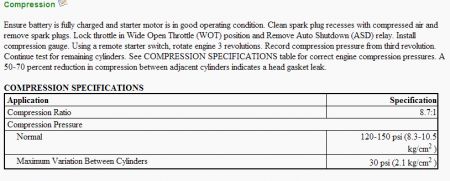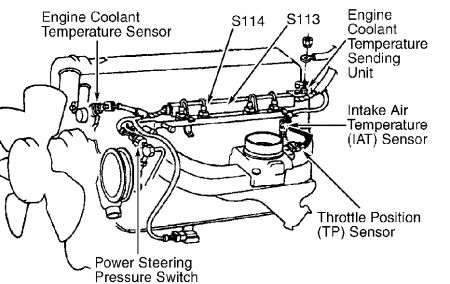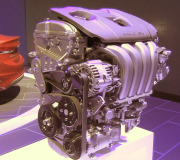FUEL PRESSURE TEST Fuel Rail With Fuel Pressure Test Port 1. Release fuel pressure. See FUEL PRESSURE RELEASE. Remove test port cap. Install a 0-60 psi (0-4.2 kg/cm 2 ) fuel pressure gauge at test port. 2. Start engine and allow to idle. Fuel pressure should be 44.2-54.2 psi (3.1-3.7 kg/cm 2 ). If no fuel pressure exists, fuel pump relay control circuit may be defective. See TEST TC-101A, in TESTS W/CODES article. 3. If fuel pressure exceeds specification, fuel pump is okay, but fuel pressure regulator is defective. Release fuel pressure and replace fuel pump module. See REMOVE/INSTALL/OVERHAUL article. 4. If fuel pressure is okay, release fuel pressure. Remove test gauge hose. Install test port cap. Fuel Rail Without Fuel Pressure Test Port 1. Release fuel pressure. See FUEL PRESSURE RELEASE. Ensure area around fuel supply line and fuel rail are clean. Note direction of latch clip installation. Latch clip is located on top of fuel supply line at fuel rail. Using 2 screwdrivers, pry latch clip upward, and remove from fuel rail. 2. Pull fuel supply line from fuel rail. Install appropriate adapter into fuel rail. See FUEL RAIL ADAPTER APPLICATION table. Ensure adapter is fully seated in fuel rail. Install adapter latch clip into fuel rail, with latch clip fingers pointing downward. If latch clip will not fully seat so latch clip fingers extend downward below fitting on fuel rail, adapter may not be fully seated in fuel rail. FUEL RAIL ADAPTER APPLICATION 3. Connect fuel supply line to adapter. Ensure fuel supply line fully seats in adapter. Remove protective cap from adapter test port, and install a 0-60 psi (0-4.2 kg/cm 2 ) fuel pressure gauge at test port. 4. Start engine and allow to idle. Fuel pressure should be 44.2-54.2 psi (3.1-3.7 kg/cm 2 ). If no fuel pressure exists, fuel pump relay control circuit may be defective. See TEST TC-101A in, TESTS W/CODES article. 5. If fuel pressure exceeds specification, fuel pump is okay, but fuel pressure regulator is defective. Release fuel pressure and replace fuel pump module. See REMOVE/INSTALL/OVERHAUL NOTE: For additional information on fuel pressure and fuel pump testing procedures, see TEST NTC-5A and appropriate NS TEST in TESTS W/CODES article NOTE: All models are equipped with a mechanical fuel pressure regulator located in fuel tank, inside fuel pump module. Excess fuel is returned to tank through fuel pressurarticle. 6. If fuel pressure is okay, release fuel pressure. Remove latch clip. Remove test equipment. Before reinstalling fuel supply line, ensure fuel supply line fitting and fitting on fuel rail are clean. Lubricate fuel supply line fitting and fitting on fuel rail with engine oil. Install fuel supply line on fuel rail. 7. Install latch clip into fuel rail, with latch clip fingers pointing downward. Ensure latch clip is fully seated. Latch clip fingers should extend downward below fitting on fuel rail when fully seated. 8. Pull on fuel supply line to ensure fuel supply line is fully locked on fuel rail. Start engine and check for fuel leaks. Application Adapter No. 4.0L 6541


Sunday, March 1st, 2009 AT 6:45 AM







